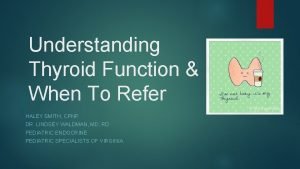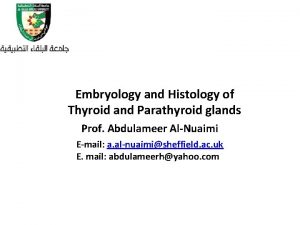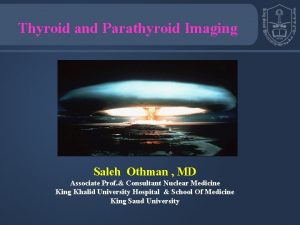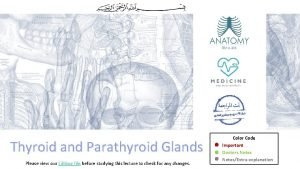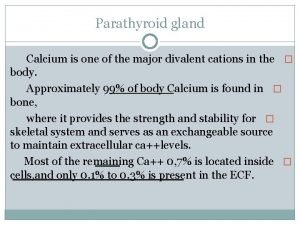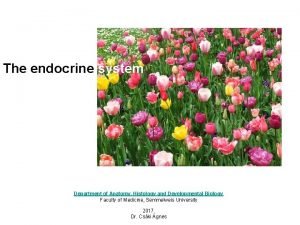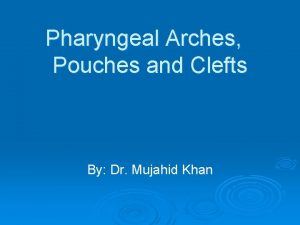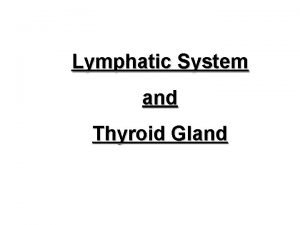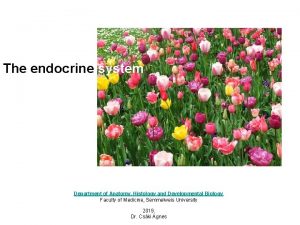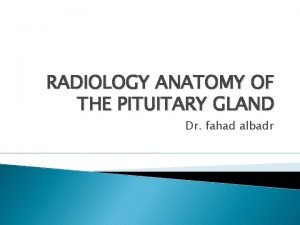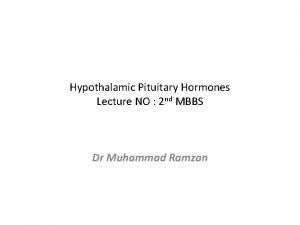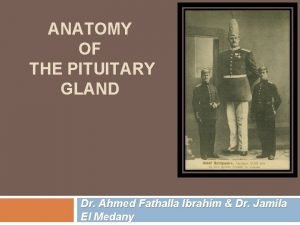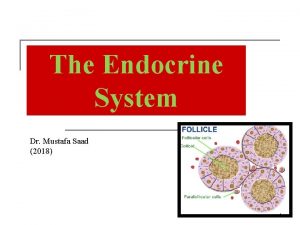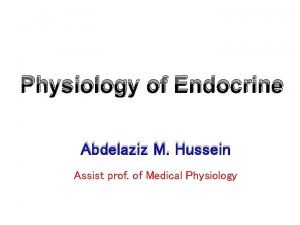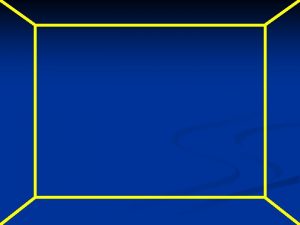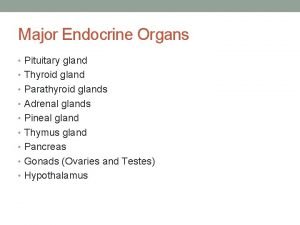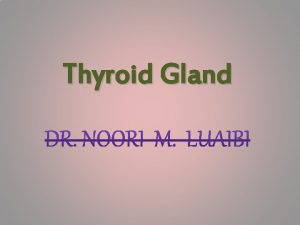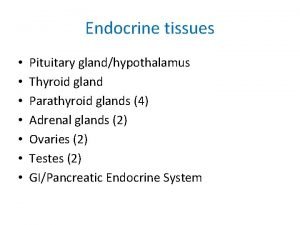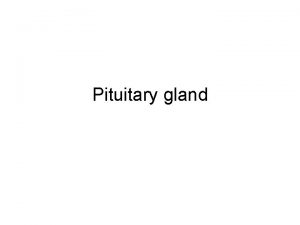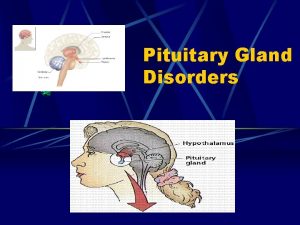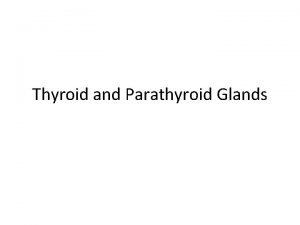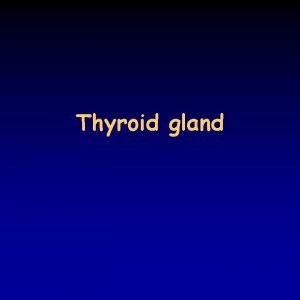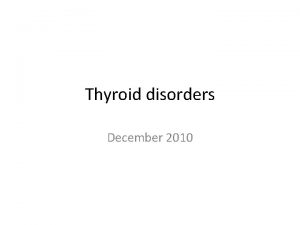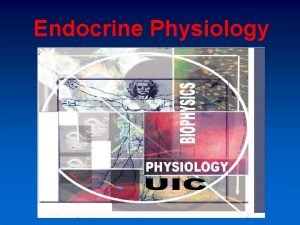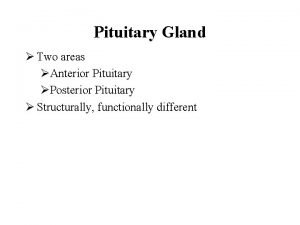ENDOCRINE SYSTEM Pituitary gland Thyroid gland Parathyroid gland

















- Slides: 17


ENDOCRINE SYSTEM Pituitary gland Thyroid gland Parathyroid gland Suprarenal gland

n n n The endocrine system is formed of a number of ductless glands, which secret hormones directly into the blood stream. These hormones circulate and exert their influence on target cells far away from their site of release. They are responsible for regulating and coordinating important physiologic functions of the body.

Pituitary Gland (Hypophysis Cerebri) n n It is considered as the master of all other endocrine glands. It is present inside the cranial cavity. It lies in a fossa in the sphenoid bone (hypophvseal fossa or sella turcica).

Pituitary Gland (Hypophysis Cerebri) n n It is covered by a fold of dura called diaphragma sellae. It is connected to the hypothalamus by pituitary stalk (infundibulum) which passes in the middle of the diaphragma sellae (the pituitary gland is controlled by hypothalamus). It is supplied by branches from the internal carotid artery. The pituitary gland is formed of 2 main parts: n Adenohypophysis. n Neurohypophysis.

n Adenohypophysis (anterior lobe): Its cells secrete the following hormones: § Growth hormone (GH): stimulates body growth. § Prolactin: stimulates mammary gland (during lactation). § Thyroid stimulating hormone (TSH): stimulates thyroid gland. § Adrenocorticotrophic hormone (ACTH): stimulates adrenal cortex. § Follicle Stimulating hormone (FSH): stimulates growth of follicle in the ovary (in females) & stimulates spermatogenesis in the testis (in males). § Luteinizing hormone (LH); Interstitial cell stimulating hormone (ICSH): § It stimulates secretion of estrogen & progesterone and ovulation (in ♀). § It stimulates release of testosterone from interstitial cells of testis (in ♂).

The hormones secreted by the adenohypophysis

n Neurohypophysis (posterior lobe): n Nerve cells present in the hypothalamus secrete: n n Oxytocin (stimulates uterus contraction). Vasopressin (ADH) (stimulates kidney to conserve water). Axons of these nerve cells carry these hormones to the posterior lobe where they terminate in relation to vessels there. These hormones then go to the blood stream. Hypophyseal portal system Ø It a capillary plexus is present in the hypothalamus. Ø This capillary plexus is connected to another capillary plexus in adenohypophysis by hypophyseal portal veins. This portal system allows the hypothalamus (through its release hormones) to regulate secretion of hormones of the adenohypophysis.


Pineal Body (Gland) n n It is small, piriform organ which is a part of the diencephalon. It lies in a depression between the superior colliculi of midbrain. It secrets melatonin (its level rises during darkness and falls during day). It is most active during darkness. Exposure to light, after several hours of darkness depresses pineal activity.

Thyroid Gland n n It is the largest endocrine gland in the body, which is butterfly in shape. It is formed of right & left lobes connected across the median plane by a narrow region, the isthmus. Each lobe is pearshaped; having apex, base and 3 surfaces.

n Its arterial supply is: n n n It lies anteriorly in the lower part of the neck: n n The apex of each lobe rests on the thyroid cartilage The base of each lobe reaches the level of 6 th tracheal ring The isthmus crosses the trachea opposite the 2 nd, 3 rd & 4 th tracheal rings It is related posteriorly to: n n Trachea and oesophagus Recurrent laryngeal nerve in between the trachea and oesophagus. n Superior thyroid artery from external carotid artery. Inferior thyroid artery from subclavian artery. Its venous drainage is: n n Superior & middle thyroid veins into internal jugular vein. Inferior thyroid vein into left innominate vein.

n The thyroid gland has two types of cells: n n Follicular cells: line thyroid follicles. They synthesize and secrete thyroid hormones Ttri-iodothyronine T 3 and Tetraiodothyronine T 4. Parafollicular cells: are present between line thyroid follicles. They secrete calcitonin (involved in calcium metabolism). Goitre: a condition of enlarged thyroid gland. Physiological goitre occurs after puberty or during pregnancy. Pathological goitre occurs due to iodine deficiency.

Parathyroid Glands n n They are 4 small, yellowish brown, ovoid glands: 2 superior & 2 inferior parathyroids They lie along the posterior borders of the thyroid lobe underneath its capsule. They receive rich blood supply from the thyroid arteries There are 2 types of cells: n n Principal cells: are small in size and secrete parathyroid hormone. Oxyphil cells: occur or in groups. They are of unknown function.

Suprarenal Glands (Adrenals) n 2 small yellowish bodies situated in relation to superior pole of each kidney: n n n Each receives 3 arteries: n n Right suprarenal is pyramidal in shape. Left suprarenal is crescentic in shape. 1 from phrenic artery. 1 from aorta. 1 from renal artery. Each has one vein: n n Right suprarenal vein drains into I. V. C. Left suprarenal vein drains into Lt. renal vein.

n Each suprarenal consists of an outer cortex and inner medulla. n The cortex: is formed of 3 zones: n Zona glomeruloza: secretes mineralocorticoids mainly aldosterone. n Zona fasciculata: secretes glucocorticoids and sex hormones. n Zona reticularis: secretes glucocorticoids. n The medulla: formed of chromaffin cells which synthesize and secrete adrenaline and noradrenaline.

THANK YOU
 Hashitoxicosis
Hashitoxicosis Pituitary gland and pineal gland spiritual
Pituitary gland and pineal gland spiritual Pineal gland pituitary gland
Pineal gland pituitary gland Thyrooid
Thyrooid Parathyroid tissue histology
Parathyroid tissue histology Shrsies
Shrsies Parathyroid gland innervation
Parathyroid gland innervation Parathyroid hormone and calcitonin
Parathyroid hormone and calcitonin Parathyroid gland chief cell
Parathyroid gland chief cell Surfaces of thyroid gland
Surfaces of thyroid gland Pharyngeal arch vs pouch
Pharyngeal arch vs pouch Is thyroid a lymphatic organ
Is thyroid a lymphatic organ Pituitary gland inferior view
Pituitary gland inferior view Venous drainage of pituitary gland
Venous drainage of pituitary gland Division of pituitary gland
Division of pituitary gland Anatomical relations of pituitary gland
Anatomical relations of pituitary gland Hypophyseal fossa and pituitary gland
Hypophyseal fossa and pituitary gland Diaphragma sellae
Diaphragma sellae
